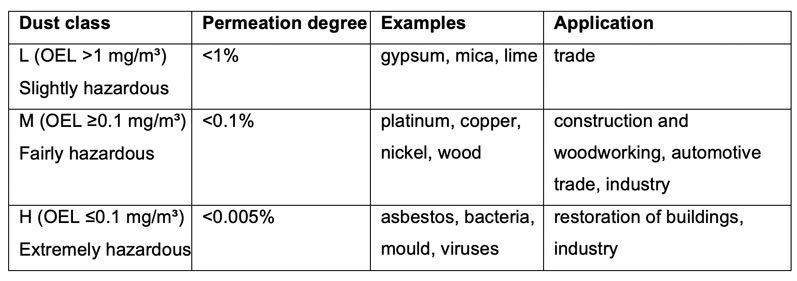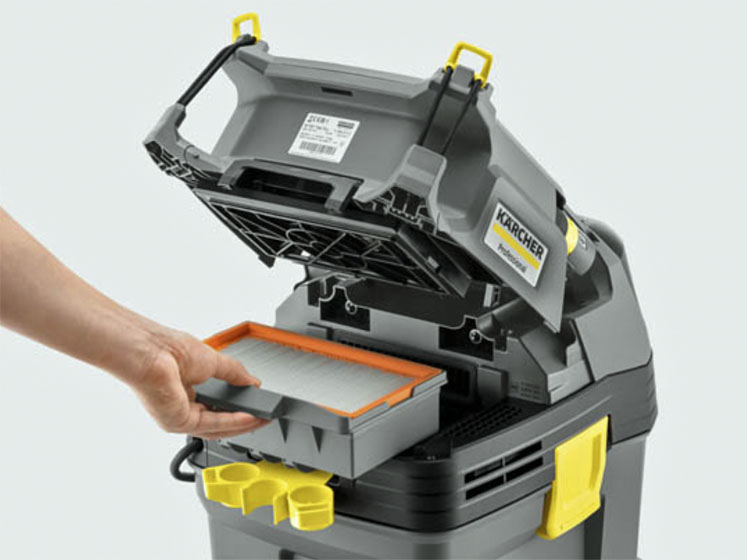Many tasks on construction sites produce large amounts of dust, requiring contractors to comply with work protection regulations and minimise any impact on heath. Kärcher Professional UK offers an array of safety vacuum cleaners to deliver on-site solutions … whatever the job may be.
Types of dust and dust classes
Even supposedly harmless types of dust can have an impact on or cause lasting damage to your health when the concentration in the air is very high. Types of dust containing constituents such as pollen, quartz, mould, viruses or even asbestos are especially problematic.
Categorising dust types in terms of the impact they have on your health depends on the grain size as well as the properties and exterior shape of the material concerned. For example, what makes asbestos dust dangerous is not only its particle size, but its special fibre structure.
Coarse dust comprises particles with a diameter of at least 10 μm. Smaller, fine dust particles (dust class E) with a grain size of between 10 μm and 0.1 μm can enter your nose, throat, larynx and wind pipe by just breathing in.
Alveoli or respiratory class A dust with a diameter of less than 0.1 μm is so fine that it can even penetrate deep into the respiratory tract and alveoli. Possible consequences of this are reduced lung function or respiratory diseases such as asthma, silicosis, fibrosis as well as COPD (chronic obstructive pulmonary disease).
Classification of vacuum and safety vacuum cleaners
Safety vacuum cleaners are designed to facilitate the reliable absorption and disposal of such particles. The Hazardous Substances Ordinance defines a concept for measuring the impact of dust. It uses the occupational exposure limit values (OELs) as a basis.
These state the concentration of dust (in mg/m³) that must not be exceeded in room air. The greater the impact of a constituent on your health, the smaller the concentration in room air must be and the more stringent the corresponding requirements for vacuum cleaners become.
These are classed in categories L, M and H – differing in filter capacity and permeation degree, which is the value that specifies the maximum amount of dust particles that the machine is allowed to release back into room air (Table I).

Class L models are suitable for vacuuming types of non-hazardous dust. Filter capacity requirements are comparatively low and there are no special disposal regulations. Machines belonging to dust class M and H retain even fine types of dust, including particles that can penetrate the respiratory tract.
Dust class H or M vacuum cleaners are also known as safety vacuum cleaners. These have specific design requirements, such as compulsory air flow monitoring, which warn operators of blockages. Operators must also take specific precautions when removing and disposing of the dust in a dust-free manner. Dust class H vacuum cleaners must be used to remove asbestos.
Developments in filter engineering
Filters are designed to collect fine dust particles and prevent them from being released back into the surrounding air. When dealing with large amounts of dust, there is a risk of this clogging up the filter and considerably reducing the suction power. Consequently, some safety vacuum cleaners, such as the current Tact M and H models by Kärcher, are equipped with filter cleaning systems. A clean filter has a higher air flow rate and enables better cleaning results.
Fully automated filter cleaning functions allow large amounts of fine dust to be vacuumed without interrupting work or losing suction power. Kärcher also uses the further developed Tact system in its safety vacuum cleaners. Here, a sudden switch of the air flow cleans the filter automatically using fresh air supplied from the outside.
Tightness plays a role here as well: the tighter the system, the greater the achievable vacuum and the better the filter is cleaned when the valve is opened suddenly.
The advantage of flat pleated filters
Flat pleated filters make it possible to fit a relatively large filter area into a very small space. More than half a square metre of filter area fits into a cassette that is barely larger than the palm of your hand. Consequently, it is possible to design very compact vacuum cleaners. Flat pleated filters that have their own housing are especially user-friendly. This makes changing the filter possible without coming into direct contact with dirt, making removal, cleaning and disposal easier.
New filter materials
Flat pleated filters are usually made of nano-coated paper or plastic, such as PES (polyethersulfone). The nano coating prevents dust particles from sticking to the filter surface and compromising its function. Unlike paper filters, PES filters are more robust and especially resistant to wet dirt and fluids.

However, neither paper nor PES filters are suitable for use in class H vacuum cleaners. Previously, only filters made of fibreglass materials were used, but this is a very mechanically sensitive material that is not washable.
New H class safety vacuum cleaners, such as those made by Kärcher, use H filters made of PTFE material. The plastic fabric combines the positive properties of fibreglass and PTFE. The filter is washable and can also be cleaned using blasts of air. This also makes it easy to efficiently clean the filter when vacuuming extremely hazardous types of dust – when removing asbestos, for example.
The new PTFE filter material also makes disposal easier. Previously, a safety filter set for dust-free disposal in H class machines was mandatory, making them comparatively laborious to use. A dust-free PE disposal bag designed especially for this purpose should suffice for washable PTFE filters, making for a much easier process.
In summary
In the last few years, many aspects of safety vacuum cleaners have been developed in terms of efficiency and user-friendliness, including more effective filter cleaning systems that allow uninterrupted operation. New materials offer a high level of convenience, even in the H class, making operation, including disposal, much easier.
